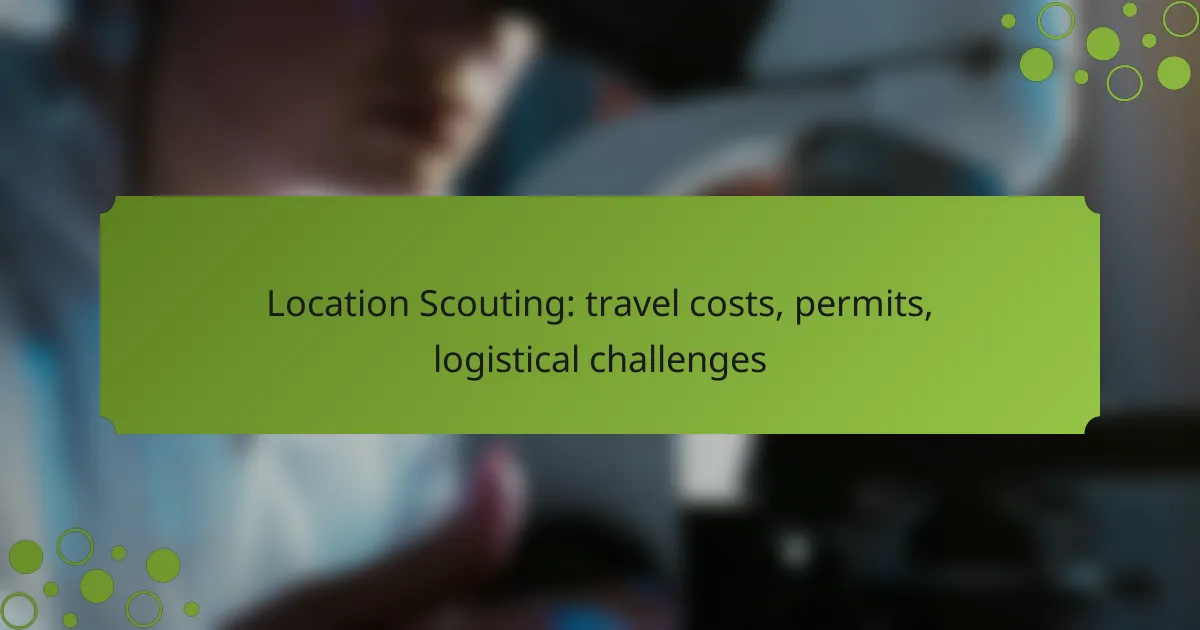Location scouting is a critical phase in the production process, particularly in diverse landscapes like Australia, where travel costs can fluctuate based on destination and crew size. Securing the necessary permits is essential to avoid legal complications, while navigating logistical challenges such as remote access and weather unpredictability can significantly impact the efficiency of the scouting process.

What are the travel costs for location scouting in Australia?
Travel costs for location scouting in Australia can vary significantly based on factors like the destination, duration, and the size of the crew. Budgeting for flights, accommodation, transportation, food, and insurance is essential to ensure a smooth scouting process.
Flight expenses
Flight expenses for location scouting in Australia can range from a few hundred to over a thousand Australian dollars, depending on the departure location and time of booking. Major cities like Sydney and Melbourne typically have more flight options and competitive pricing.
Booking in advance and being flexible with travel dates can help reduce costs. Consider using flight comparison websites to find the best deals.
Accommodation rates
Accommodation rates in Australia vary widely based on location and type of lodging. In urban areas, expect to pay anywhere from AUD 100 to AUD 300 per night for hotels, while budget options like hostels may cost around AUD 30 to AUD 80 per night.
For longer scouting trips, consider renting an apartment or using services like Airbnb, which can offer more space and amenities at competitive rates.
Transportation fees
Transportation fees for location scouting can include car rentals, fuel, and public transport costs. Renting a vehicle typically costs between AUD 40 to AUD 100 per day, depending on the type of car and rental duration.
In cities, public transport can be a cost-effective option, with daily passes usually ranging from AUD 10 to AUD 20. Always factor in the distance between locations when planning your budget.
Food and daily allowances
Food costs can add up quickly during location scouting. Budget around AUD 15 to AUD 30 per meal at casual dining establishments, while groceries can be a more economical choice, averaging AUD 70 to AUD 150 per week per person.
Establishing a daily allowance for meals can help manage expenses. A reasonable daily food budget might be around AUD 50 to AUD 80 per person.
Insurance costs
Insurance costs for location scouting in Australia are crucial for protecting against potential liabilities. General liability insurance can range from AUD 300 to AUD 1,000 annually, depending on coverage limits and specific needs.
Consider obtaining coverage that includes equipment and travel insurance, which can add a few hundred dollars to your overall budget but is essential for safeguarding your investment during the scouting process.

What permits are required for location scouting in Australia?
Location scouting in Australia typically requires various permits depending on the nature of the shoot and the locations involved. Understanding the specific permits needed can help streamline the process and avoid legal issues.
Filming permits
Filming permits are essential for any commercial shoot in Australia, especially in urban areas or popular tourist destinations. These permits are issued by local councils or state authorities and may require an application fee, which can vary widely based on location and duration of the shoot.
It’s advisable to apply for filming permits well in advance, as processing times can range from a few days to several weeks. Be prepared to provide details about the shoot, including dates, times, and the number of crew members involved.
Location agreements
Location agreements are contracts between the production team and property owners that outline the terms of use for a specific location. These agreements should detail the duration of the shoot, any fees, and responsibilities for damages or disruptions.
Having a signed location agreement protects both parties and ensures clarity on expectations. It’s wise to negotiate terms that are mutually beneficial, especially regarding access times and any potential restrictions.
Public land access permits
When scouting locations on public land, such as national parks or beaches, you will need a public land access permit. These permits are typically issued by government agencies and may include specific conditions to minimize environmental impact.
Fees for public land access permits can vary, and some locations may have restrictions on the types of equipment you can use. Always check the specific regulations for the area you plan to scout to ensure compliance.
Private property permissions
For shoots on private property, obtaining explicit permission from the property owner is crucial. This may involve negotiating terms and possibly compensating the owner for the use of their space.
Documenting this permission in writing is recommended to avoid misunderstandings. Ensure that you clarify any limitations on the use of the property, such as noise restrictions or access times, to maintain a good relationship with the owner.

What logistical challenges are faced during location scouting?
Location scouting involves various logistical challenges that can impact the efficiency and success of the process. Key issues include access to remote locations, unpredictable weather conditions, local regulations, and the transportation of equipment.
Access to remote locations
Gaining access to remote locations can be one of the most significant challenges in location scouting. These areas may require special permits or permissions, and travel can involve lengthy journeys over difficult terrain. It’s essential to plan for potential delays and have backup locations in mind.
Consider using local guides who are familiar with the area, as they can provide valuable insights and facilitate access. Always check the accessibility of roads and paths, especially if scouting during off-peak seasons when conditions may change.
Weather conditions
Weather can greatly affect location scouting, influencing both the feasibility of accessing sites and the quality of visuals captured. Rain, snow, or extreme temperatures can hinder travel and alter the appearance of locations. Always check long-term forecasts and prepare for sudden changes.
When scouting, it’s wise to have alternative dates in mind or to scout multiple locations to mitigate the impact of adverse weather. Carrying weather-appropriate gear and being flexible with your schedule can help ensure a successful scouting trip.
Local regulations
Local regulations can pose challenges during location scouting, especially in urban areas or protected environments. Permits may be required for filming or photography, and these can take time to obtain. Understanding local laws and regulations is crucial to avoid fines or legal issues.
Research the specific requirements for each location ahead of time. Contact local authorities or film commissions to clarify what is needed and ensure compliance with all regulations before proceeding with your plans.
Equipment transportation
Transporting equipment to scouting locations can be logistically complex, particularly for remote or rugged sites. Consider the weight and volume of your gear and plan accordingly for transportation methods, whether by vehicle, boat, or on foot.
It’s beneficial to create a checklist of essential equipment and to pack only what is necessary for the scouting trip. If possible, use lightweight and portable gear to ease transportation. Additionally, consider the availability of local rental options to reduce the burden of transporting heavy equipment.

How to budget for location scouting in Australia?
Budgeting for location scouting in Australia involves estimating travel costs, securing necessary permits, and addressing logistical challenges. Understanding these elements helps ensure a smooth scouting process while keeping expenses manageable.
Cost estimation techniques
To effectively estimate costs for location scouting in Australia, start by breaking down expenses into categories such as transportation, accommodation, meals, and permits. Research average costs in the specific regions you plan to scout, as prices can vary significantly between urban and rural areas.
Utilize online tools and local resources to gather data on transportation options, such as flights and car rentals, and consider using a budgeting app to track expenses in real-time. A rough estimate for daily costs might range from AUD 150 to AUD 300, depending on location and personal preferences.
Contingency planning
Contingency planning is crucial for location scouting to address unexpected challenges, such as weather changes or permit delays. Allocate an additional 10-20% of your budget for unforeseen expenses, ensuring you have the flexibility to adapt as needed.
Additionally, create a backup plan for locations in case your primary choice becomes unavailable. This could include alternative sites that offer similar visual appeal, allowing you to stay on schedule without incurring significant extra costs.

What are the best practices for efficient location scouting?
Efficient location scouting involves thorough planning, understanding travel costs, securing necessary permits, and addressing logistical challenges. By following best practices, you can streamline the process and minimize delays and expenses.
Travel costs
Travel costs can significantly impact your location scouting budget. Consider expenses such as transportation, accommodation, meals, and local transport. Depending on the location, these costs can vary widely; for instance, urban areas may have higher hotel rates compared to rural settings.
To manage travel costs effectively, create a detailed budget that includes all potential expenses. Use online tools to compare flight and hotel prices, and consider booking in advance to secure better rates. Additionally, look for group discounts if traveling with a team.
Permits
Securing the right permits is crucial for legal compliance during location scouting. Different locations have varying regulations regarding filming or photography, which may require permits from local authorities. Research the specific requirements for your chosen locations well in advance.
To avoid delays, contact local film commissions or relevant government offices to understand the permit application process. Be prepared to provide details about your project, including dates, locations, and the nature of the shoot. Allow sufficient time for permit approvals, as this can take several weeks.
Logistical challenges
Logistical challenges can arise from various factors, including transportation issues, equipment handling, and communication barriers. Anticipating these challenges is key to a successful scouting trip. Create a detailed itinerary that outlines travel routes, timelines, and contact information for local resources.
Consider using local guides or fixers who understand the area and can assist with navigation and local customs. Additionally, ensure that your equipment is suitable for the locations you plan to scout, and have backup plans in place for unexpected situations, such as weather changes or access restrictions.
